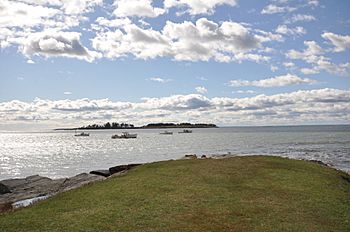Richmond Island facts for kids

Richmond Island, as seen from Kettle Cove State Park in Cape Elizabeth, Maine
|
|
| Geography | |
|---|---|
| Location | Gulf of Maine |
| Coordinates | 43°32′38″N 70°14′5″W / 43.54389°N 70.23472°W |
| Area | 226 acres (91 ha) |
| Administration | |
| State | Maine |
| County | Cumberland County |
| Town | Cape Elizabeth |
|
Richmond's Island Archeological Site
|
|
| Nearest city | Cape Elizabeth, Maine |
| Area | 195 acres (79 ha) (listed area) |
| Built | 1628 |
| NRHP reference No. | 78000175 |
| Added to NRHP | November 2, 1978 |
Richmond Island is a small island located off the coast of Cape Elizabeth, Maine in the United States. It is also sometimes called Richmond's Island. The island was named after Ludovic Stewart, 2nd Duke of Lennox and 1st Duke of Richmond.
Today, Richmond Island is privately owned and no one lives there. It is famous because it was once a very important fishing spot in the 1600s. In 1978, the island was added to the National Register of Historic Places. This was because of the important old remains found there from the fishing post.
Contents
Island Location and Size
Richmond Island is found near the southern coast of Cape Elizabeth. It is close to the top end of Saco Bay in the Gulf of Maine. The island covers about 226 acres (91 ha) of land.
What's on the Island Today?
No one lives on Richmond Island permanently. The only buildings there are a small lodge, a place for a caretaker, and a boat dock. These are all on the island's northwest side. The Sprague Corporation owns the island. If you want to camp there, you need to ask them for permission.
Early History of Richmond Island
The first person known to live on Richmond Island was Walter Bagnall. He started a fishing business there in 1627. He worked there until 1631, when he died.
A Permanent Fishing Post
In 1631, an English merchant named Robert Trelawney received official permission for land in the area. He sent a man named John Winter to set up a lasting fishing station on the island. From 1633 to 1643, John Winter ran the station. He had about 40 men working with him.
They built a large house and also grew crops on the land. The fishing station was made strong to protect against possible attacks. These threats came from local Native American groups and the French settlement at Fort Pentagouet in Penobscot Bay.



